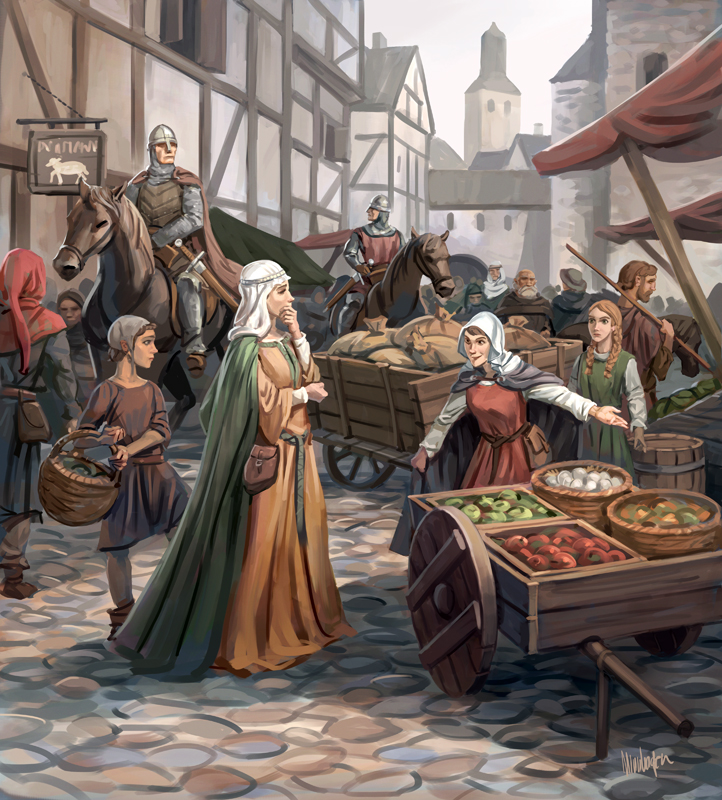 |
| Catoctin Furnace |
Often, when we design an adventure area or campaign map, we place a few dots on the map to represent a few different hamlets or villages the adventurers may visit on their way to wealth and experience. We might outline a few NPCs and some minor details about a town, but probably don't give it much more thought than that. A few of us nerdlings may go overboard in the opposite direction and develop a full history of the town and its environs....
But, if you are like me, you're probably somewhere in the middle... You want some engaging details for your players, but are not interested in the laborious task of a historical backstory for the entire region.
So I'm throwing out a few ideas that might help make this part easier, perhaps even fun.
World Building One Hamlet at a Time
1) First and most importantly, consider your town's reason for existence.
Everything has its reason for existence in the world. For population centers, that reason is almost always economic. If you're creating a pseudo-medieval setting, this is almost always related to trade goods. Consider the raw materials or finished products that create the primary industry in the town you are detailing.
2) Next, consider what trades are necessary for the industry to function.
Often we might consider the local farmers and the guy or gal that runs the Colored Animal Inn, but really don't look much beyond that. It's in the "looking beyond" that makes a town come to life (for the PCs and the DM) rather than becoming "generic village #3" on the map. By thinking about the trades necessary, you get a better view of the local citizenry and are likely to include people and trades that you may not have even considered.
 |
| Source: Deviant Art |
A market town will be packed with travelers bringing in goods to hawk at week's end. There will be tents and stalls and crowds buying and selling wares. A town which features a tannery and leather working will smell pretty bad. Most of the dwellings will be upwind from the activities, but the poorer section of town will be withing stinking distance. A foundry town will have a near constant plume of black smoke rising from the industrial side of town. The blast furnace chimney may be one of the largest and most visible structures when approaching the village.
4) Lastly, if you really want deep details, consider how the economic activity of the town might affect the surrounding areas or the important NPCs within the town. How might it affect the local politics? Are there rivalries (both friendly or even violently hostile) that develop due among the movers and shakers of the economy?
At this point your creative juices may be flowing like a river, but again, you don't have to write up a whole backstory or history of the area. A few simple sentences may be enough to flesh out the town so that its no longer one dimensional in your mind. It's not important that the players (or even you) learn all there is to know about the town. It's more important that you know what's the typical day to day activity so that you can come up with fun, little details on the fly when your PCs visit the area.
Here's a quick example:
I was looking up the Catoctin Forge when I decided to create a village for my game featuring a similar structure.
Town: Odelyn's Forge
Population: 500
Industry: Iron works
Trade goods: Pig iron (raw), iron finished goods (cook pots, plow blades, horse shoes, etc), charcoal, wool, goat cheese
Tradesmen: Miners, Founders, Smiths, Woodsmen, Teamsters, Shepherds
Place of interest: Foundry, Mine, Chapel, Hostel, Logging Camp
Odelyn's Forge was conceived when Lady Odelyn Dunhill discovered an exposed vein of hematite on the lands of her father, Lord Dunhill. After securing the charter for the surrounding acreage as a part of her inheritance, Lady Odelyn arranged for mining operations and the construction of the forge nearby. The village of Odelyn's Forge was founded when numerous trades people and their families moved into the area to service the mining and foundry activities. Though still relatively small in population, Odelyn's Forge is growing and rising economically as demand for the pig iron grows.
[Update: I fleshed out this location even further in this article.]
Why bother with seemingly minor details such as the industry and trade goods? I'm going to use the "V" word here, so forgive me... Verisimilitude. The more real a town feels, the more immersion not only your players, but you also, will get out of the game.
As your players explore, you might think to throw in some random details that will bring the town and its residents to life in ways you hadn't even planned. Instead of some random farmer on the road, perhaps they encounter a soot-covered fire stoker walking back in the evening from his shift in the forge. It's the little details that may be completely off-the-cuff that will often be remembered by your players. With the extra village detail you developed during your campaign preparation, you will be better armed to throw out these kinds of improvised scene descriptors later.
Final Thought
If you give each small town some purpose in life, you go from having a map of random dots to having a living, breathing economy which may even give you and your players ideas and hooks for other action and adventures.
Links for Inspiration:
Appreciated your insight and ideas for making a town come alive. Thank you.
ReplyDelete